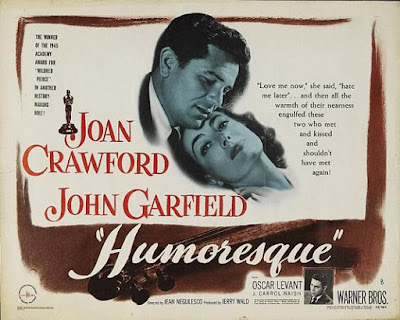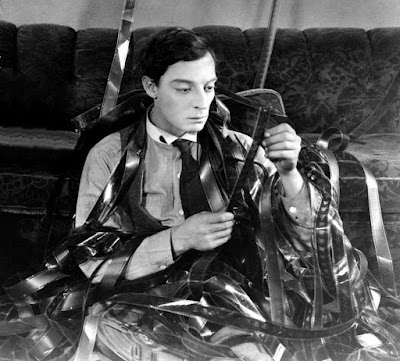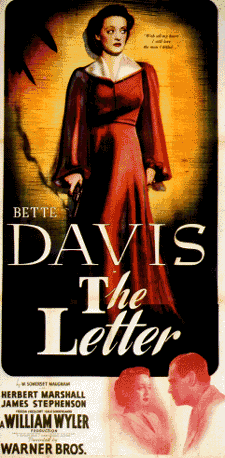"All my life I wanted to do the right thing. But it never worked out. I'm outside always looking in, feeling all the time I'm far away from home, and where home is I don't know. I can't get back to the simple, happy kid I use to be."
--John Garfield's opening scene from Humoresque
 |
| A devastated John Garfield after Joan Crawford's death: the opening scene of Humoresque, 1946 |
In the early 1990s, I became infatuated with Oscar Levant. I'm not sure why, but I assume his wisecracking movie roles, especially in 1946's Humoresque, had a lot to do with it. This Warner Brothers movie--a kind of rip-off of Clifford Odets' (who co-wrote this film) Golden Boy--won me over the first time I saw it many, many years ago. The soapy film starred Joan Crawford as an alcoholic, married, society dame (as co-star, John Garfield's character refers to her) who has a fondness for--as Garfield's cynical sidekick Oscar Levant so aptly puts it--"la vie boheme." Joan Crawford, who had been released by Metro-Goldwyn-Mayer (MGM) studios in 1943 after nearly twenty years, was considered somewhat washed up in Hollywood by the mid-Forties but made a huge comeback in 1945 with Mildred Pierce, grossing millions for Warners and nabbing an Oscar for Best Actress of 1945. Humoresque was her follow up to that classic film.
John Garfield--second billed--was also hitting a career peak after the 1945 film, Pride of the Marines (another underrated gem), and the noir scorcher, The Postman Always Rings Twice, opposite Lana Turner. Here, Garfield plays Paul Boray, a Lower East Side kid with a talent for the fiddle. (The violin playing was dubbed by the great Isaac Stern, who also served as Garfield's hand double. The effect, still impressive some seventy years later, was achieved in the film by cutting the sleeves of Garfield's coat and shirt, allowing Stern's hands to substitute Garfield's.) Oscar Levant plays Garfield's piano-playing friend (i.e., second banana) who gets the film's best lines. It's Oscar Levant playing Oscar Levant, which means a little piano and a lot of observation about life and love. Cutting remarks from the sidelines include, "It's not what you are, it's what you don't become that hurts." And,"I didn't make the world, I barely live in it." Levant's film career was just taking off at this point, despite his appearance in seven previous films. His most prominent role to date was the George Gershwin biopic, Rhapsody in Blue, released just a year before Humoresque, with Levant playing himself (he always played a variation on his own personality in his films, but in Rhapsody he was billed as Oscar Levant playing "Oscar Levant").
 |
| The three performers with the most screen time in the film |
The film begins with Paul Boray as a child of eight years or so played by Bobby Blake, aka, Robert Blake (yeah, that Robert Blake) In Humoresque, he is quite affecting as a boy his parents don't really understand, especially his Papa (J. Carroll Naish). Momma (Ruth Nelson) gets him a bit more, but she is also a controlling type who who thinks no woman is good enough for her boy. Time goes by in one of those time-lapse montage Warners did to perfection in the Forties, and before you know it, little Paul Boray is a fully grown John Garfield, still practicing his violin while living at home. Fed up with a family that perceives him as a freeloader, Paul seeks out his piano-playing friend, Sid Jeffers (Oscar Levant), for advice on how to get ahead playing violin.
 |
| A young Robert Blake with Oscar Levant, Humoresque, 1946 |
Sid suggests going to the the home of Victor and Helen Wright. The Wrights are always hosting a party, and, as Sid tells Paul, he has been invited to a few for laughs: "I laugh at them or they laugh at me. I forget which." It's here--nearly 30 minutes into the film--that leading lady Joan Crawford appears. Crawford, playing Helen Wright, a married, neurotic, self-destructive society dame who drinks too much and likes to help struggling young artists, takes one look at Garfield's Paul playing his violin and is a goner ... though not before blowing cigarette smoke in his face as he is playing. Paul, however, is more than up for the challenge, playing Rimsky-Korsakov's "Flight of the Bumblebee" after telling Helen that "New York is full of all kinds of animals. Not all of them are human." From this fateful introduction, we know they will fall in love. Tragic love. Besides Paul's complex relationship with Helen, he has a pseudo romance with childhood friend and fellow musician, Gina, played by Joan Chandler. (It's Gina who Momma feels is the right woman for her Paul, not that lush, Helen Wright.)
 | |
| In case I failed to mention it, Humoresque is the kind of movie where the characters throw perfectly good cocktails against walls. |
As their relationship deepens, Helen helps the talented Paul get an agent, and, as his fame in the rarefied world of classical music increases, a penthouse suite overlooking the East River. Despite all this success the couple's relationship is stormy at best. While listening to Wagner's Tristan und Isolde on the radio, the fragile, distraught Helen kills herself by walking into the Atlantic Ocean--a highly dramatic finish. It's in moments like this that the film simultaneously embraces and transcends its melodramatic, over-the-top qualities. These are also the moments that the film's detractors hold against it. For me, though, the tragic, nearly operatic melodrama is why I love the film so much. The cinema just doesn't make films as unapologetically romantic as Humoresque any more, and that's a real shame.
Made for two million dollars, Humoresque is an impeccably crafted film. From its editing by studio favorite Rudi Fehr, the art direction of Hugh Reiticker, Joan Crawford's wardrobe by Adrian, the brilliant cinematography of Ernest Haller, the incredible work of Franz Waxman's music score, and Leo B. Forbstein's orchestration of the classic works of Wagner, Bizet, Divorak among others, the film stands as a time capsule of craftsmanship that has been lost in the shuffle of other, better known, films. Humoresque may contain Crawford's best performance--maybe even better than her Oscar-winning role in Mildred Pierce. Helen Wright is certainly a more complex role than Mildred, and Crawford hits all the right notes as a tragic woman for whom long-term happiness is an illusion. As for my buddy Oscar, I feel that this movie contains his best impersonation of himself, better than Rhapsody in Blue. Some may grow weary of his constant cynicism, but in this ultra-romantic setting, it's a relief--a bit of reality in this unrealistic-yet-touchingly-romantic fable of impossible love.
Sources: The Films of John Garfield by Howard Gelman
The Films of Joan Crawford by Lawrence J. Quirk
John Garfield, The Illustrated History of the Movies by George Morris
Joan Crawford, The Illustrated History of the Movies by Stephen Harvey
Wikipedia Page on Humoresque





































